The Story Behind Shrek Forever After
Once upon a time, there lived an ogre…

Never count your donkeys before they’ve had a chance to wisecrack.
Unless that donkey happens to have a giant green ogre as a best friend, another pal in the furry form of Puss In Boots, and the weight of a phenomenally successful film franchise behind him…
No, we’re not talking in fairytale riddles. But we are telling a story – that of Shrek Forever After .
See, Shrek’s always done things his own way – just look at all those debunked fairy stories – which explains why DreamWorks Animation green-lit the ogre’s fourth adventure even before the third had hit screens. (That’s what we mean by the donkey thing…)
“I think Shrek ’s really funny and very well made,” says Donkey himself, Eddie Murphy. “I think it’s that simple. It’s really well made. It’s very funny. It’s smart and those things add up to a hit sometimes.”
But let’s not get ahead of ourselves. Let’s start at the very beginning, in a land far, far away called, funnily enough, Far Far Away…
Next: Once Upon A Time, There Lived An Ogre... [page-break]
Bringing all the latest movie news, features, and reviews to your inbox
Once Upon A Time, There Lived An Ogre...
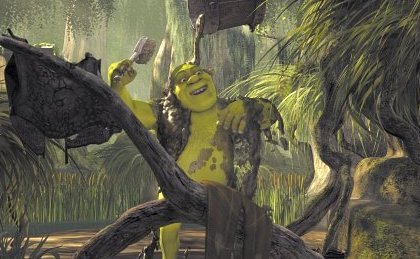
And he was a mean, foul-tempered old thing with skin the colour of slime. He liked no-one and revelled in his filthy way of life.
Not only that, but Shrek – for that was his name – was voiced by comedian Mike Myers (in a dodgy faux-Scottish burr), and took great pleasure in tormenting his fellow fairytale creatures in the lands of Far Far Away.
Yet despite being an ugly green ogre with no obvious redeeming qualities, Shrek was actually a hero. See, his adventure was the animated creation that saved DreamWorks Animation from an early grave...
In the face of some other animated studio known as Pixar, DreamWorks were struggling. Deciding that they wanted to take William Steig’s children’s book Shrek! and turn it into a movie, they toiled for several years, utilising 275 artists and 2.5m computer hours to finally bring it to the big screen.
On the way, there were hiccups: they struggled to move away from CGI being cold by attempting to make their characters as lifelike and heartfelt as possible, while star Mike Myers decided he wanted to re-record his original voice track and make Shrek Scottish – at a cost of $5m in lost man hours.
Remembers Myers, “When Jeffrey [Katzenberg] said ‘Would you like to be in an animated movie?’, I said, ‘Yes.’ He said, ‘It’s a movie called Shrek .’ I said, ‘That’s the worst title I’ve ever heard in my life.’”

By all accounts, though, the funnyman was glad to get the role after first choice Chris Farley passed away:
“When they told me about the movie and said that Eddie Murphy, Cameron Diaz and John Lithgow were in it, I told them right away, 'I'm in,'” Myers said at the time.
“I loved the whole idea behind the story, which is that you're beautiful, so don't let other people tell you that you're not just because you don't look like the people in magazines. Or because you're not that weird ideal body image that's out there right now.”
In the end, Shrek became the not-little ogre that could, wowing audiences. Bowing in Cannes in 2001, the film then nabbed the first ever Oscar for Best Animated Feature.
Then came Shrek 2 , which surpassed its predecessor in both style and storytelling, breaking the then box office record for biggest animated opening ever.
Shrek The Third followed in 2007, and despite negative reviews it still raked in the cash like a money-hungry villainess. Clearly, DreamWorks had hit upon a winning formula.
But now word came that they were going to kill the franchise off…
Next: But He Wasn't Happy With His Life... [page-break]
But He Wasn’t Happy With His Life…
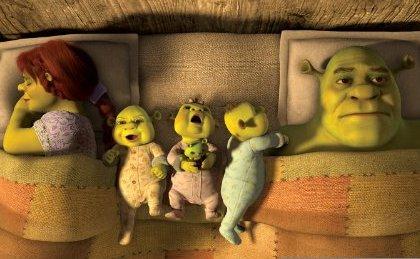
Of course, that was always a part of the plan from the beginning. Skipping trilogy mania in favour of a more storybook-like four chapters, the Shrek film series was always envisioned as a quartet. And now the time had come to say goodbye.
But how to go about it? That was the question facing the film’s producers, and newly-signed director Mike Mitchell (he of the decidedly not-animated Surviving Christmas and Deuce Bigalow: Male Gigalo ).
Still, despite Shrek not being a trilogy, its final chapter took the general ‘final part’ rules of a trilogy in order to sew everything up nicely – namely, take things back to the beginning.
“We thought it was interesting that Shrek’s not the ogre he was in the first Shrek films,” says Mitchell, who was drawn to an image that Shrek artists came up with early in production of Shrek 4 , in which the ogre stood staring into a mirror at his original ‘wanted’ poster.
“He’s domesticated, he’s not scary, he’s beloved by all the townspeople,” the director adds. “The last thing we wanted was for Shrek to lose his edge.”
There was no fear of that, though - even if things took a stumble at the first hurdle. Tim Sullivan wrote the first script for the fourquel, tentatively titled Shrek Goes Fourth . It was rumoured to have revealed Shrek’s origins – how he came to the swamp, prequel-style.
But Date Night writer Josh Klausner hit upon a rather different idea that retained Shrek as the central character while putting a spin on the Shrekverse thus far: what if Shrek went back in time?

“That turned into a very relatable wish fulfilment,” says Mitchell. “We all think of returning to our past, turning the clock back, to live life over.”
Adds producer Teresa Cheng: “We knew we had to keep the story fresh, yet give it a new twist. We asked ourselves, ‘What more can Shrek learn on his journey as an ogre?’"
In the end, it was a spin on It’s A Wonderful Life that really lit up the DreamWorks offices, with Shrek now growing weary of his suddenly and forcibly domesticated life.
He’s no longer the fearsome ogre he once was – in fact, his swamp is now a tourist attraction for those who want to catch a glimpse of the green-skinned goliath and his clan.
So, in an act of desperation, Shrek signs away a single day from his life to devious no-gooder Rumpelstiltskin in exchange for a day spent in the bliss of his past grumpy existence.
Instead, Shrek finds himself in a strange alternate past where he never saved Princess Fiona from the tower, and never befriended Donkey or Puss In Boots. Meanwhile, Rumpelstiltskin has become king of Far Far Away.
“The result is nothing short of catastrophic,” says Mitchell…
Next: So A Magic Spell Was Cast... [page-break]
So A Magic Spell Was Cast…
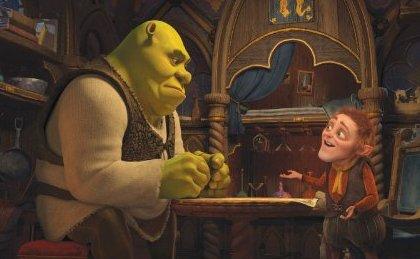
The alternate reality story was perfect for a final chapter in the Shrek saga, according to its makers.
“It seemed like a great springboard,” says producer Gina Shay. “Shrek begins to ask himself a lot of questions about what it means to be an ogre. We went back to the basics and root of his journey.
“We knew this film really needed to be Shrek’s story, told through his eyes. Shrek begins to wonder who he's become and what life might have been like if he had never rescued Fiona from the tower.”
Now in a Far Far Away overcast in darkness, Shrek must figure out what went wrong, and how to fix it. Not before he stumbles upon a few familiar faces, stretched into different versions of their former selves…
“I think you get to see true love happen all over again for the first time between Shrek and Fiona because they get to find one another,” says Cameron Diaz, who returns as Fiona.
“It’s your favourite moment from the first movie that you get to experience all over again. You get to take that journey with them of finding that love again.
“You open up on two of them in the routine of a life that they’ve taken for granted - Shrek has for sure - and then you get to see him journey back through trying to regain finding his true love. You get to fall in love with Shrek and Fiona all over again.”
In this warped alt-present, Fiona has transformed into a powerful, battle-ready ogre. Having tired of waiting for Prince Charming to rescue her from her lofty tower, in this reality Fiona took the initiative and rescued herself.
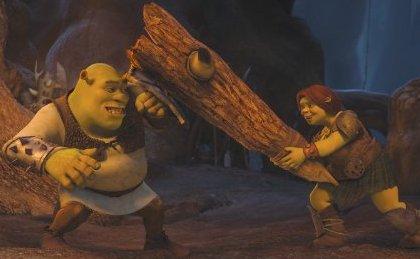
“For me, Fiona’s always been a warrior,” argues Diaz. “I’ve always seen her as that. She’s been a warrior of love through all of these films.
“It is very empowering, a little ‘I am ogress, hear me roar!’”
Meanwhile, Puss In Boots has become fat and lazy, preferring to doze his days away rather than fight the various forces of evil. For Antonio Banderas, the new angle on his character was a welcome one.
“When they came up with this story of an alternative reality and all the characters not really knowing each other, it was almost like it started from the beginning, almost like a new movie,” he says.
“I thought it was just a fantastic concept, and the re-imagination of Puss as this spoiled, pampered pet is inspired.”
Diaz is quick to assign credit where it’s due, though, stressing: “The animators are great and they’re really the great actors. They are the ones who put the looks in our eyes and create the chemistry between us.”
Like previous Shrek adventures, it was to be a collaborative effort that really fused all of the talent involved. “We would come into a session with just script pages and give the actors the set-up and they just trusted us,” says director Mike Mitchell. “It’s a great collaboration."
In fact, the world has now become so complete by the fourth adventure, that it’s hard to believe that all of these characters don’t actually exist in the real world.
“The thing that stuck out with me more than anything is that I’m still having an emotional reaction to Shrek and Fiona and wanting them to get together,” says Eddie Murphy, whose Donkey is wandering Far Far Away having never known Shrek.
“You get so caught up in the story that you kind of have to remind yourself that you’re watching animation!”
Next: A New, Twisted Midget King Seized The Throne... [page-break]
A New, Twisted Midget King Seized The Throne…
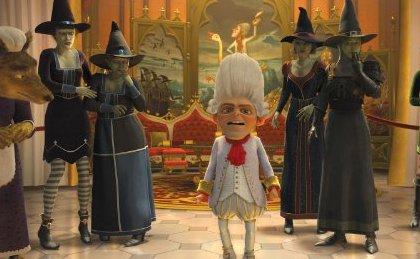
“The villains from all the Shrek films are so great,” says Walt Dohrn, who serves as head of story on Shrek Forever After – and also, by a turn of luck, as Rumpelstiltskin himself.
“We asked, ‘What do we do to get to that level of villain? How do we create a fresh new villain suitable for the final face-off with Shrek?’”
In the end (and contrary to persistent rumours that Tom Cruise would be voicing the antagonist), it was Rumpel who fit the part.
Based on the Brothers Grimm creation, he’s the conniving little snit who excels in lies and destructive deals – and in the movie, with his flamboyant wigs and outfits, more than passingly resembles Sir Elton John.
“We pretty much knew from the onset that Rumpelstiltskin would be our villain,” reveals executive producer Aron Warner. “We just didn’t know what kind of villain he’d turn out to be.”
Having previously lent his voice to Shrek The Third for a handful of different characters (including Nanny Dwarf, Evil Knight and unforgettably, um, Singing Villain), Dohrn helped out reading the part of Rumpel during recording sessions with the other actors... and soon it became apparent that he was perfect for the role.
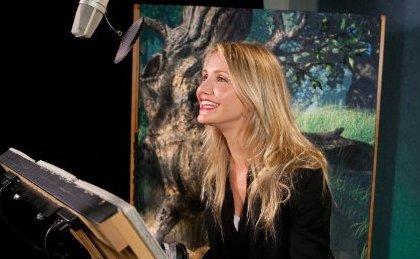
“Walt’s performance really sealed the deal on this character,” says Jason Reisig, head of character animation.
“When we heard him just doing the temporary test voice [ of Rumpel ] in our story reels, we just fell in love with the character and a lot of it was just because of that voice and what Walt brought to it.”
For inspiration, Dohrn turned to the unlikely duo of Sean Penn in The Falcon And The Snowman and Bette Davis in What Ever Happened To Baby Jane? (“Drama,” notes Dohrn, “Rumpel takes himself very seriously.”)
Faced with voicing a full, lead character on the fourquel, the sudden voice actor didn’t turn tail in panic, instead savouring the chance to flesh out his own terrifying antagonist.
“Farquaad, Fairy Godmother and Charming are very eloquent characters,” says Dohrn. “We went to the opposite end of that spectrum and went for a character that was ratty and scummy, but charming at the same time.”
As Mitchell says: "You know the guy that wins the $200 million mega lottery jackpot and doesn't really know how to spend the money? That’s Rumpel.”
Next: And The Land Fell Into Darkness... [page-break]
And The Land Fell Into Darkness…
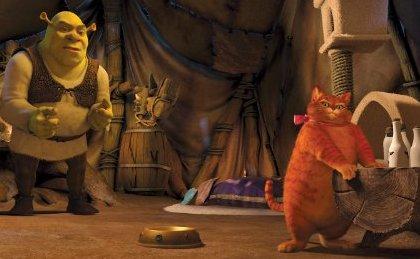
Alright, so we’ve got the same world but somehow… different. Seems pretty straight forward, right? Not according to Mitchell.
“It was a real challenge when we set out to define the look of the film,” he says. “We really wanted to give this film a different look while at the same time, be true to the world of Shrek .”
Mitchell and co were impressed with designer Peter Zaslav’s creations for the Christmas special Shrek The Halls – in particular the sight of Shrek’s house covered in snow.
“It was familiar, but still very unique,” says Mitchell. “I knew then that we would be able to pull off the alternate reality from a design perspective.”
In order to really make the differences between real Far Far Away and the land it is replaced with in Shrek’s alternate reality, the designers brightened the reality at the beginning of the film – turning it into something of a happy rainbow land in comparison to the last two Shreks.
Then, in the alt world, the film’s colour palette is emboldened with gold, greens and greys – inspired by the shades used in the contract that Shrek signs for Rumpel.
“Gold has become a dominant visual theme associated with Rumpelstiltskin and that actually gets propagated to the entire environment,” says Zaslav.
“We’ve gotten used to the world of Shrek - all the green trees, the green lush grass. In the alternate reality, all that green gives way to more yellows and golds.”

Signalling the darkness of the movie is the upped amount of night-time scenes (thankfully the cast didn’t have to suffer through night shoots, a small blessing).
Most notably, this new Shrek is the first in the series to be shot and released in stereoscopic 3D – a definite boon to the visual side of things.
“3D is an equal partner in everything we do. We don’t look at it as an afterthought,” says Cooper. “We’ve given a lot of careful thought into the staging of our shots - designing them to take advantage of stereo.”
The film’s ambition also extended to its inclusion of various new characters, including bounty hunter the Pied Piper, who lures people using his melodies.
For a sequence in which the ogres are placed under the Pied Piper’s spell and dance madly in response, Mitchell brought in Michael Rooney to choreograph.
Not only that, but 30 dancers were enlisted to shoot a video that the animators could turn to for a reference.
“It’s actually a pretty elaborate and complex sequence,” say Mitchell. “We were lucky enough to get Michael Rooney to come in and actually choreograph the dance sequence for us.”
Next: But The Ogre Fought To Break The Spell... [page-break]
But The Ogre Fought To Break The Spell…

That’s the problem with wish fulfilment, see – you’ve got to be careful what you wish for. As Shrek soon discovers, what he wanted wasn’t what he really wanted at all.
Which leads him on a quest to restore order to his world, win back the girl and destroy Rumpelstiltskin. Can he do it? It’s the final chapter, so anything could happen.
Stateside, Shrek Forever After has definitely been having a fairytale ending. Despite a disappointing opening of $70m (by comparison, Shrek 2 opened with $108m), it has now ridden the charts to a very healthy $229m total.
“This film’s legacy – and all the films – is really quite extraordinary,” notes Cameron Diaz. “What Shrek, Donkey, Fiona, Puss have all accomplished, and what they’ve given the audiences is something we’re all very proud of, and I’m proud to have been a part of the journey.”
The critics were also relatively happy. Though observing that Shrek Forever After didn’t quite reach the heights of the first two adventures, they accepted that it was a marked improvement on the series’ lacklustre third entry.
“How do we give the audience what they know and love, but at the same time give it a fresh take, make it more beautiful?” Mitchell asks. “We’ve taken on the bittersweet challenge of wrapping up the story of Shrek. We know fans would want to see how it ends.”
Shrek’s adventures may be over for now, but Antonio Banders’ Puss In Boots spin-off is already in the works.
“It’s sad on the one side, and on the other side, yes, it got to continue its own saga,” says the actor. “I hope it goes well. But it’s totally different.
“It goes in a different direction and takes more from Sergio Leone’s kind of 60s movies, probably Western. We divide the screens and stuff like that. It is a lot of fun too, but it is a different context.”
As for the Shrekkers, how about a reunion a decade down the line? “I’m in,” says Diaz.
“The final chapter reunion movie?” muses Myers. “Yes, sure. I just play the voice. I don’t really know what goes on.”
And they all lived happily ever after.
Shrek Forever After opens on 2 July.
Like This? Then try...
Sign up for our free weekly newsletter here .
Follow us on Twitter here .
Josh Winning has worn a lot of hats over the years. Contributing Editor at Total Film, writer for SFX, and senior film writer at the Radio Times. Josh has also penned a novel about mysteries and monsters, is the co-host of a movie podcast, and has a library of pretty phenomenal stories from visiting some of the biggest TV and film sets in the world. He would also like you to know that he "lives for cat videos..." Don't we all, Josh. Don't we all.


